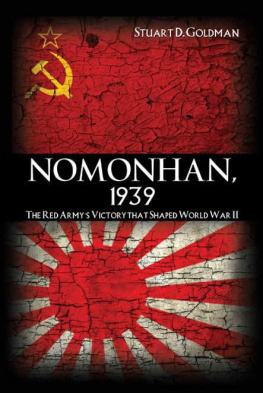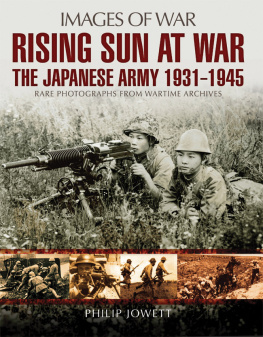NOMONHAN,
1939

| STUART D. GOLDMAN |
NOMONHAN,
1939
_______________________________________
THE RED ARMYS VICTORY THAT SHAPED WORLD WAR II
Naval Institute Press
Annapolis, Maryland
The statements of fact, opinion, or analysis expressed in this book are those of the author and do not reflect the official policy or position of the Department of Defense, the U.S. Government, or the U.S. Navy.
Naval Institute Press
291 Wood Road
Annapolis, MD 21402
2012 by Stuart D. Goldman
All rights reserved. No part of this book may be reproduced or utilized in any form or by any means, electronic or mechanical, including photocopying and recording, or by any information storage and retrieval system, without permission in writing from the publisher.
Library of Congress Cataloging-in-Publication Data
Goldman, Stuart D. (Stuart Douglas), 1943-
Nomonhan, 1939 : the Red Army victory that shaped World War II / by Stuart Goldman.
p. cm.
Includes bibliographical references and index.
ISBN 978-1-61251-098-9 (ebook) 1. Khalkhin Gol, Battle of, Mongolia, 1939. 2. Russo-Japanese Border Conflicts, 19321941. 3. MongoliaStrategic aspects. 4. Manchuria (China)Strategic aspects. 5. Soviet Union. Raboche-Krest?ianskaia Krasnaia ArmiiaHistoryWorld War, 19391945. 6. World War, 19391945Causes. I. Title.
DS798.9.H33G65 2012
952.033dc23
2011048511
 This paper meets the requirements of ANSI/NISO z39.48-1992 (Permanence of Paper).
This paper meets the requirements of ANSI/NISO z39.48-1992 (Permanence of Paper).
19 18 17 16 15 14 13 12 9 8 7 6 5 4 3 2 1
First printing
FOR MY SISTER CAROL,
WHO CHEERED ME ON FROM THE SIDELINES
THROUGH THE DOUBLE MARATHON OF THIS BOOK, AND
PASSED AWAY JUST BEFORE I CROSSED THE FINISH LINE

CONTENTS

T he first glimmering of this project came in the summer of 1965 when I happened upon a footnote in Barbarossa , Alan Clarks masterful history of the German-Soviet struggle in World War II. Clark cited Georgy Zhukovs 1939 defeat of the Japanese at Khalkhin Gol as an important battle. With a brand-new masters degree in history and the nave belief that I was something of an expert on the Second World War, I was dubious that there could even have been a major Soviet-Japanese conflict in 1939 of which I was unaware. Finding myself in Washington, D.C., with time on my hands, I went to that cathedral of learning, the Library of Congress, and for the first time in my life undertook a serious research project that was not an academic requirement. I discovered that Khalkhin Gol (aka Nomonhan) was indeed a major conflict and the Library of Congress had a lot of unpublished material on the subject. I was struck by the fact that the peak of the fighting coincided with the conclusion of the German-Soviet Nonaggression Pact and wondered, even then, if there might be some connection. I could hardly imagine that this modest quest would shape my career, or that I would later spend thirty years as a research analyst in the Library of Congress.
A year later I was back in school, a PhD candidate at Georgetown University. For Tom Heldes research seminar on modern European diplomatic history, I wrote a paper on the Soviet-Japanese conflict and its possible link to the nonaggression pact. Professor Helde, chairman of the History Department, said, in effect, Goldman, you have the makings of a doctoral dissertation here. For that, and Heldes role in securing for me a university fellowship, I will always be grateful. I also had the good fortune of having Prof. Joseph Schiebel as my dissertation adviser. Academe is notorious for its pettiness. Joe Schiebel took the highly principledand unusualposition that even though I disagree with your underlying interpretation of Stalins foreign policy, the argument you make in support of your thesis is as plausible as my own, and I will be proud to have my name associated with your work.
A broad-based work of scholarship necessarily stands on the shoulders of others. My interpretation of Soviet foreign policy in the 1930s generally follows Adam Ulams magisterial Expansion and Coexistence . I am also indebted to George A. Lensens multivolume chronicles of Soviet-Japanese diplomatic relations in the interwar period. I cannot fail to mention the Japanologist, Alvin D. Coox, whose exhaustively detailed books on Changkufeng ( The Anatomy of a Small War ) and especially Nomonhan: Japan Against Russia, 1939 , made him the acknowledged American expert on these battles. The many footnote references to his work in this book acknowledge his mastery. When I was a graduate student, Professor Coox graciously offered research guidance. He later paid me the compliment of viewing me as a competitor and rival.
When I was still a young assistant professor of history, John K. Fairbanks, dean of American Asian scholars and president of the American Historical Association, saw promise in my project and helped me win an AHA grant to begin Japanese language study at Columbia Universitys East Asian Institute. Two years later, a Japan Foundation Fellowship provided for a year in Tokyo studying Japanese and doing research on Nomonhan, which proved invaluable for this project. There I had the help of a brilliant young research assistant, Kose Nariaki, who guided me through the intricacies of prewar Japanese writing and the labyrinth of Japanese archives. Nariaki died tragically in a mountaineering accident at age twenty-seven. A former Library of Congress colleague, Nobuko Ohashi, generously helped me as interpreter, interviewing retired Japanese army officers in Tokyo. Later, Natella Konstantinova put in countless hours helping me comb through Soviet-era documents.
The renowned military historian, John Toland (Pulitzer Prize for The Rising Sun ), was kind enough to read an early version of this manuscript and encourage me to stick with it and seek publication. My friend, David L. Robbins (author of War of the Rats, Last Citadel, Liberation Road, The End of War, Broken Jewel , and many other novels) has been unstinting in his advice and encouragement.
Imanishi Junko, associate director of the Atsumi International Scholarship Foundation, provided invaluable support for my participation in an international symposium on Nomonhan in Ulaanbaatar. The Sekiguchi Global Research Association of Japan and the Aratani Foundation of Los Angeles provided generous financial support for this symposium and my travel. My five-day adventure driving across the Mongolian steppe and touring the Nomonhan battlefield would have been impossible without my loyal interpreter, Tom Urgoo, and resourceful driver, Enkhbat.
My friend, Sambuu Dawadash, a Mongolian diplomat and adviser to the prime minister, was tireless and enterprising in his support of this project and rendered invaluable assistance in the United States and Mongolia. Former Mongolian ambassador to the United States, Dr. Ravdan Bold, whose father was at the Battle of Khalkhin Gol, provided valuable information on the events of 1939 and helped me gain access to the battlefield. Ambassador Khasbazar Bekhbat, who succeeded Dr. Bold as ambassador in Washington, has also been most helpful.
My friend, Capt. John Rodgaard, USN (Ret.), historian, intelligence officer, and technical expert, provided invaluable advice and support, not least of all by introducing me to Rick Russell, director of the Naval Institute Pressone of a handful of people who, years ago, had actually read my doctoral dissertation on which this book is based. What are the odds of that? Thanks also to Adam Kane, my editor at Naval Institute Press, who made the process of turning a manuscript into a book remarkably painless.












 This paper meets the requirements of ANSI/NISO z39.48-1992 (Permanence of Paper).
This paper meets the requirements of ANSI/NISO z39.48-1992 (Permanence of Paper).